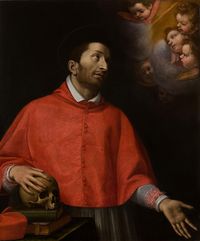Difference between revisions of "High Pontiff Daniel III"
| Line 35: | Line 35: | ||
|} | |} | ||
| + | '''Daniel III''' ([[Common]]: ''Daniel III''; [[High Imperial]]: ''Daniel III'') (17th of Malin's Welcome, 1526 – present), given the epithet '''the Blind''' for his lack of eyesight near the end of his tenure, was High Pontiff between 1552 and 1562. Daniel, formerly known '''Prince Charles Francis''' of the [[Holy Orenian Empire]], also served in numerous other positions, most notably as Duke of Ghorrack for 1542 to 1544 as well as one of his [[John I, Holy Orenian Emperor|father's]] ambassadors and courtiers. | ||
| − | + | Daniel was elected High Pontiff after the passing of his long-time rival and opponent, [[High Pontiff Tobias I|Tobias I]], and proclaimed a return to 'the era of [[High Pontiff Daniel I|Daniel I]] and [[High Pontiff Everard II|Everard I]]'. Despite such, Daniel III frequently quarreled with his fellow clergy during the majority of his time in the papal throne. His multitude of attempted reforms (majority of which surrendered power to the [[Holy Orenian Empire|Empire]]) was liked by only a select few of the canonical body, and he came under heavy scrutiny after appointing his own son as Lord Vicar and viscount of the pontifical lands. | |
| − | + | The tension reached a breaking point when Daniel III proclaimed his controversial 'Revelations', a manifesto declaring his selected successor (the future [[High Pontiff Theodosius I|Theodosius I]]) and the Church's underlying role to the Orenian Empire. By petition of the clerical body, led by multiple disenfranchised bishops and cardinals, Daniel III was forced to abdicate, and most of his reforms revoked. | |
| − | + | He would be sent to Aeldin to serve in a Canonist monastery, under strict guard. | |
= Issue = | = Issue = | ||
Revision as of 14:06, 13 August 2016
|
Daniel III (Common: Daniel III; High Imperial: Daniel III) (17th of Malin's Welcome, 1526 – present), given the epithet the Blind for his lack of eyesight near the end of his tenure, was High Pontiff between 1552 and 1562. Daniel, formerly known Prince Charles Francis of the Holy Orenian Empire, also served in numerous other positions, most notably as Duke of Ghorrack for 1542 to 1544 as well as one of his father's ambassadors and courtiers.
Daniel was elected High Pontiff after the passing of his long-time rival and opponent, Tobias I, and proclaimed a return to 'the era of Daniel I and Everard I'. Despite such, Daniel III frequently quarreled with his fellow clergy during the majority of his time in the papal throne. His multitude of attempted reforms (majority of which surrendered power to the Empire) was liked by only a select few of the canonical body, and he came under heavy scrutiny after appointing his own son as Lord Vicar and viscount of the pontifical lands.
The tension reached a breaking point when Daniel III proclaimed his controversial 'Revelations', a manifesto declaring his selected successor (the future Theodosius I) and the Church's underlying role to the Orenian Empire. By petition of the clerical body, led by multiple disenfranchised bishops and cardinals, Daniel III was forced to abdicate, and most of his reforms revoked.
He would be sent to Aeldin to serve in a Canonist monastery, under strict guard.
Issue
Prince Charles Henry, Viscount of Visigia (1543-present)
Prince Henry Joseph of Furnestock (1543-present)
Julia Adelheid of Furnestock (1544-present)
